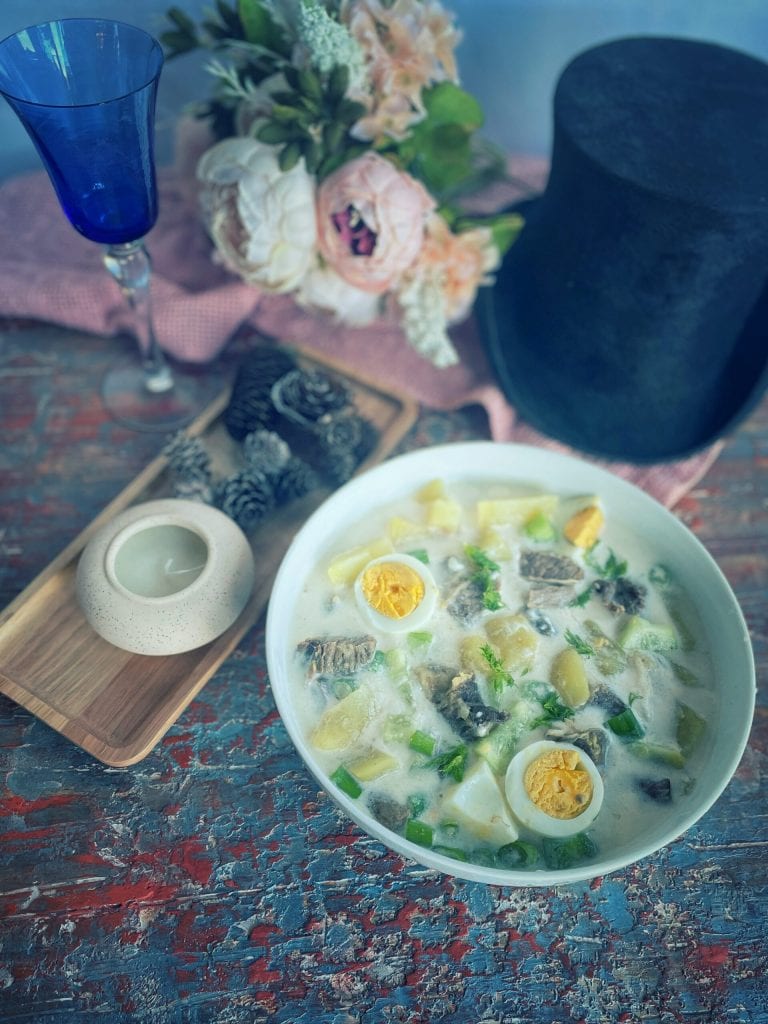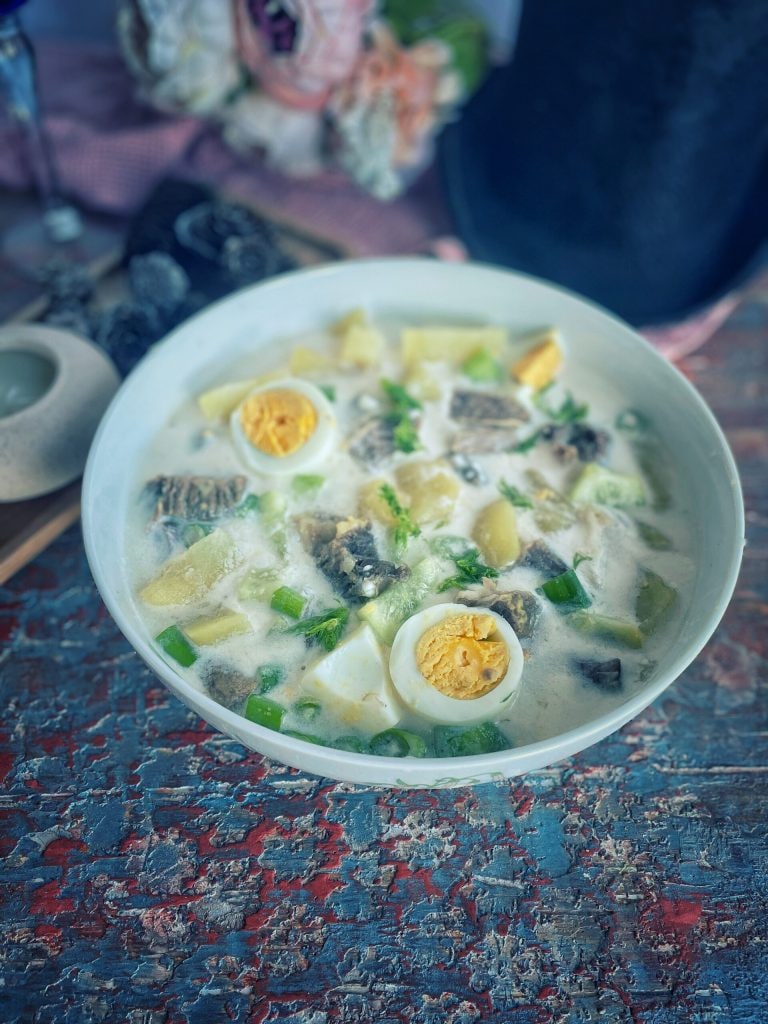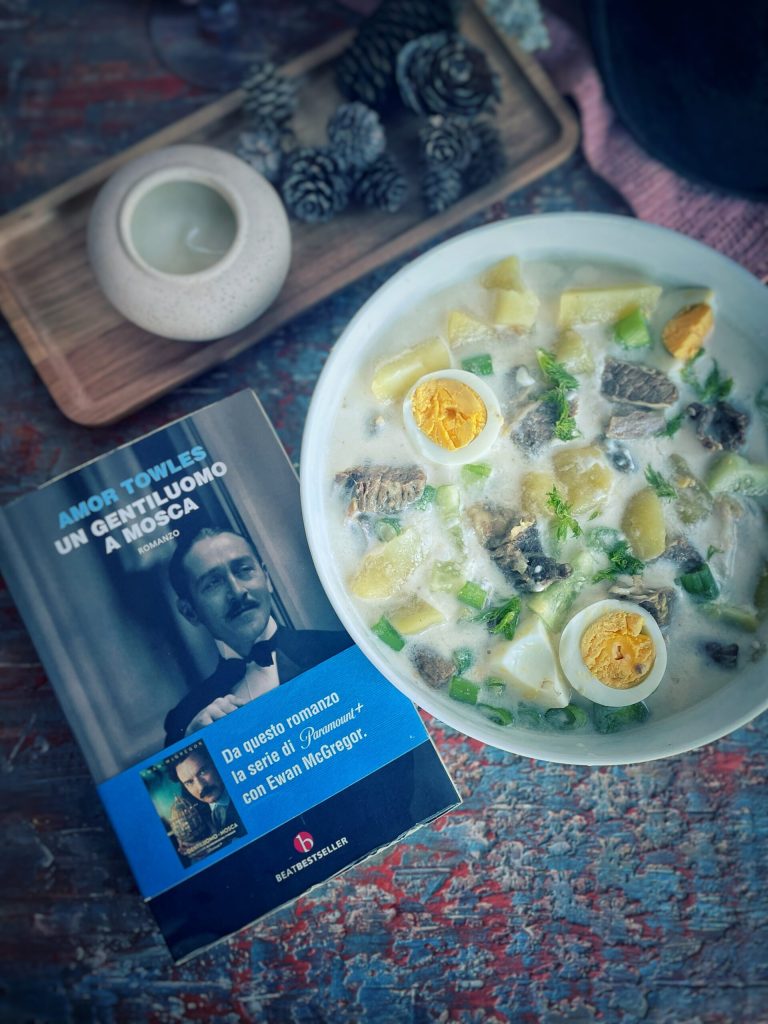Okróshka (окро́шка) is a cold soup of Russian origin, likely from the Volga region.
The classic recipe is a mix of mostly raw vegetables (such as cucumbers, radishes, and green onions), boiled potatoes, eggs, sometimes cooked meat (beef, veal, sausages, or doktorskaja), kvas, a low-alcohol drink (1.5% or less) made from fermented black or rye bread, dill, and the essential smetana (sour cream).
Later versions, appearing for the first time during the Soviet era, use kefir (окрошка с кефиром) light or diluted with sparkling water, whey, ayran (yogurt-based drink), or carbonated water and lemon, instead of kvas at the time of serving.
Culinary historians attribute the soup’s origin to the barge haulers on the Volga River called burlaks (бурлаки), who ate dried fish for lunch and rehydrated it with kvas.
Others believe that agricultural laborers were the first to consume it.
The word “okroshka” is rather ancient and derives from a word meaning “mixture”.
The recipe for Okróshka is dedicated to the mini TV series “A Gentleman in Moscow” nominated for a Golden Globe for best actor Ewan McGregor in a mini-series.
The plot: Count Aleksandr Il’ič Rostov in 1922 is sentenced due to his social class to spend the rest of his life at the Hotel Metropol in Moscow.
While the Soviet regime sinks into Stalinist tyranny, the count lives a life rich in affections and adventures, through years that offer a fresco of the political events occurring from the transition of Imperial Russia to the Soviet Union, up until 1954.
The recipe is indeed part of the:

- Difficulty: Very Easy
- Cost: Economical
- Preparation time: 15 Minutes
- Portions: 4 People
- Cooking methods: No Cooking
- Cuisine: Russian
- Seasonality: All Seasons
Ingredients
- 1 cucumber
- 5 radishes
- 2 green onions
- 2 boiled potatoes
- 2 hard boiled eggs
- 1.1 lbs beef for boiling (or veal, or sausage or doktorskaja)
- 4 cups kvas (or beer, or 1/4 cup of kefir)
- 3/4 cup smetana (sour cream)
- to taste salt
- to taste dill
Steps
Chop all the vegetables and eggs into cubes.
Boil the meat for 1 hour and a half and chop it as well.
Combine the vegetables, eggs, and meat in a soup bowl. Adjust with salt.
Mix the kvas with sour cream, or kefir with 1 cup of sparkling water.
Add the liquid to the vegetables, garnish with dill and serve the cold soup.

Okróshka in Literature
Okróshka is mentioned both on page 56 and page 506 of the wonderful book from which the TV series was adapted: “A Gentleman in Moscow” by Amor Towles (2016), as beautiful as the TV series.
Okróshka is mentioned both on page 56 and page 506 of the wonderful book from which the TV series was adapted: “A Gentleman in Moscow” by Amor Towles (2016), as beautiful as the TV series.
But not only…
But not only…
The first recipe for okroshka is found in “The Ancient Housewife, Governess, and Russian Scullery Maid” (1790) by Nikolai Osipov:
The first recipe for okroshka is found in “The Ancient Housewife, Governess, and Russian Scullery Maid” (1790) by Nikolai Osipov:
Almost simultaneously, a recipe also appears in “Russian Cookery” by Vasily Lyovshin (1795-1798) where we find a more familiar version:
“It is made with various leftovers of roasted meat, game, and domestic animals, but the best for this recipe are turkey, pheasant, and suckling pig.
Remove the meat from the bones, finely chop it with raw onion, fresh or pickled cucumbers; add pickled prunes pitted; mix again, crush with a spoon, moisten with cucumber or pickled prune brine or vinegar; let it rest, then pour kvas over and serve.“
Remove the meat from the bones, finely chop it with raw onion, fresh or pickled cucumbers; add pickled prunes pitted; mix again, crush with a spoon, moisten with cucumber or pickled prune brine or vinegar; let it rest, then pour kvas over and serve.“
Yekaterina Avdeyeva in her “Handbook for the Experienced Housewife” (1842) :
“Okroshka: use the rest of a roast, whatever you have on hand (except suckling pig and pork, which are not suitable because they are too fatty), chop it into pieces, chop green onions, dill, cucumbers, hard-boiled eggs, and shrimp necks if you have them on hand.
Mix everything together, add good kvas, salt, and let it rest. If you like, you can add two tablespoons of fresh sour cream.”
Mix everything together, add good kvas, salt, and let it rest. If you like, you can add two tablespoons of fresh sour cream.”
The cold soup was even served at a formal reception at the St. Petersburg palace.
This is confirmed by a recipe from the book by Ignatius Radetzky “St. Petersburg Cuisine”, published in 1862, a kind of chronicle of the capital’s finest cuisine of the time.
This is confirmed by a recipe from the book by Ignatius Radetzky “St. Petersburg Cuisine”, published in 1862, a kind of chronicle of the capital’s finest cuisine of the time.
The memoirist Vasily Insarsky wrote in “Old Days in Russia” in 1904:
“On the hottest days at dinner there was always okroshka, or kholodnik made in the “Malorossian” way, which the prince always praised and loved to describe how it was invented“

FAQ (Questions and Answers)
Is Okróshka with or without meat?
Cows were usually slaughtered in autumn, when cold okroshka was no longer served at the table.
In spring and summer, people used pickled beef, which was the only way to preserve meat before the invention of refrigerators.
In large city markets, “fresh meat” replaced “pickled meat” all year round.
Fresh meat became available to Russians starting from the 1820s and 1830s.
And if a hundred or two hundred years earlier foreign travelers complained that when they tried to buy a couple of pounds of beef they were told they had to buy a whole cow, by the early 19th century everything changed. And it became less common to tenderize and “finish” the meat with vinegar.
Today we know that vinegar is added to ready-to-cook meat in stores. Cooks used the same process a long time ago. Hence the addition of vinegar in 18th-century okroshka.
In the 1960s, canned meat or good quality hot dogs began to be chopped and added.

